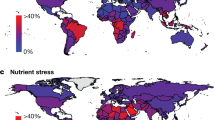Abstract
To achieve global food security by 2050 primary production must almost be doubled, at least to 80 % by increasing production per unit land. The challenge to plant breeding is tremendous. It is necessary to convince the public of this challenge, who are already dealing with concerns about climate change, a scarcity of good arable land, the demands placed on land with regard to biomass production, scarcity of water and phosphorous as well as increasing consumption of meat. In terms of breeding, concerns are the very small number of major crops and low rates of breeding progress in self-pollinating cereals. Society and politicians can be easily distracted from the dire need to invest in basic breeding research and breeding applications when so many environmental concerns are being emphasized. A holistic approach to these problems is essential. The focus here is on both the obstacles to be overcome and the opportunities to ensure global food security by producing excellent germplasm by 2050. This can be achieved by new technologies and genomics as well as the continuing development of more traditional breeding methodologies.
Similar content being viewed by others
References
Babcock BA (2008) Charting growth in food demand. Iowa Ag Rev 14(3):1–3. http://www.card.iastate.edu/iowa_ag_review/summer_08/IAR.pdf
Babcock BA, Fabiosa J F (2011) The impact of bioethanols and ethanol subsidies on corn prices: revisiting history. CARD Policy Brief, 11-PB 5. Iowa State University, Ames. .http://www.card.iastate.edu/publications/dbs/pdffiles/11pb5.pdf
Brisson N, Gate P, Gouache D, Charmet G, Oury FX, Huard F (2010) Why are wheat yields stagnating in Europe? A comprehensive data analysis for France. Field Crop Res 119:201–212
European Academies Scientific Advisory Council (EASAC) (2011) Plant genetic resources for food and agriculture: roles and research priorities in the European Union. EASAC policy report 17. ISBN 978-3-8047-3017-5. http://www.easac.eu/fileadmin/PDF_s/reports_statements/Easac_12_PGR_complete_Web.pdf
FAO (2009) How to feed the world in 2050. Food and Agriculture Organization of the United Nations, Rome. http://www.fao.org/fileadmin/templates/wsfs/docs/expert_paper/How_to_Feed_the_World_in_2050.pdf
FAO (2010) Bioenergy and food security. The BEFS analytical framework. environment and natural resources management series no. 16. Food and Agriculture Organization of the United Nations, Rome. http://www.fao.org/docrep/013/i1968e/i1968e.pdf
FAO (2011) FAO Water Reports 36. Climate change, water and food security by Hugh Turral, Jacob Burke and Jean-Marc Faurès. Food and Agriculture Organization of the United Nations, Rome. ISBN 978-92-5-106795-6. http://www.fao.org/docrep/014/i2096e/i2096e.pdf
Fischer RA, Edmeades GO (2010) Breeding and cereal yield progress. Crop Sci 50:85–98
Gilbert CL (2011) Food reserves in developing countries: trade policy options for improved food security. ICTSD Programme Agricultural Trade and Sustainable Development. Issue Paper No. 37. International Centre for Trade and Sustainable Development, Geneva. http://ictsd.org/downloads/2011/12/food-reserves-in-developing-countries.pdf
Graybosch RA, Peterson CJ (2010) Genetic improvement in winter wheat yields in the Great Plains of North America, 1959–2008. Crop Sci 50:1882–1890
Jansa J, Frossard E, Stamp P, Kreuzer M, Scholz RW (2010) Future food production as interplay of natural resources, technology and human society. J Ind Ecol 14:874–877
Kranjak-Berisavljevic G, Osman-Elasha B, Shah WP, Stone JMR (2009) Climate change. In: McIntyre BD, Herren HR, Wakhungu J, Watson RT (eds) Agriculture at a crossroads, IAASTD, synthesis report, Island Press, Washington DC. ISBN 978-1-59726-550-8
Lobell DB, Schlenker W, Costa-Robins J (2011) Climate trends and global crop production since 1980. Science 333:616–620
Lougheed T (2011) Phosphorus paradox: scarcity and overabundance of a key nutrient. Environ Health Perspect 119(5):A209–A213
Lusser M, Parisi C, Plan D, Rodriguez E (2011) New plant breeding techniques. State-of-the-art and prospects for commercial development. EUR-Scientific and Technical Research series-ISBN 978-92-79-19715-4. http://ftp.jrc.es/EURdoc/JRC63971.pdf
Pimentel D (2006) Soil Erosion: a food and environmental threat. Environ Dev Sustain 8:119–137
Pimentel D, Berger B, Filiberto D, Newton M, Wolfe B, Karabinakis E, Clark S, Poon E, Abbett E, Nandagopal S (2004) Water resources, agriculture and the environment. College of Agriculture and Life Sciences, Cornell University, Ithaca. http://ecommons.cornell.edu/bitstream/1813/352/1/pimentel_report_04-1.pdf
Reynolds M, Foulkes MJ, Slafer GA, Berry P, Parry MAJ, Snape JW, Angus WJ (2009) Raising yield potential in wheat. J Exp Bot 60:1899–1918
Rijsberman FR, Manning N (2006) Beyond more crop per drop. Water management for food and environment, 4th World Water Forum, 16–22. March, Mexico. http://www.unwater.org/downloads/Beyondmorecropperdrop.pdf
Soil and Water Conservation Society (SWCS) (2003) Conservation implications of climate change: soil erosion and runoff from cropland. Soil and Water Conservation Society, January 2003, Ankeny. http://www.swcs.org/documents/filelibrary/advocacy_publications_before_2005/Climate_changefinal_112904154622.pdf
Sundquist B (2010) Topsoil loss–causes, effects, and implications: a global perspective. 9th edn, March 2011 (updated September 2011). http://home.windstream.net/bsundquist1
UNEP/GRID (2008). http://www.grida.no/graphicslib/detail/projected-gains-losses-for-countries-under-doha-scenario-for-agriculture_ec84 (03 Jan 2008—by IAASTD/Ketill Berger, UNEP/GRID-Arendal)
World Bank (2009) World Development Report 2010: development and climate change ISBN: 978-0-8213-7987-5. (http://www-wds.worldbank.org/external/default/WDSContentServer/IW3P/IB/2010/02/22/000334955_20100222030300/Rendered/PDF/530770WDR02010101Official0Use0Only1.pdf
World Bank (2011) World Bank Group President Robert B. Zoellick, Remarks at the Opening of the World Bank/IMF spring meetings April 14, 2011, Press Conference Washington DC. http://go.worldbank.org/GQ5QMIVQ10
Zhu XG, Long SP, Ort DR (2010) Improving photosynthetic efficiency for greater yield. Annu Rev Plant Biol 61:235–261
Author information
Authors and Affiliations
Corresponding author
Rights and permissions
About this article
Cite this article
Stamp, P., Visser, R. The twenty-first century, the century of plant breeding. Euphytica 186, 585–591 (2012). https://doi.org/10.1007/s10681-012-0743-8
Received:
Accepted:
Published:
Issue Date:
DOI: https://doi.org/10.1007/s10681-012-0743-8




